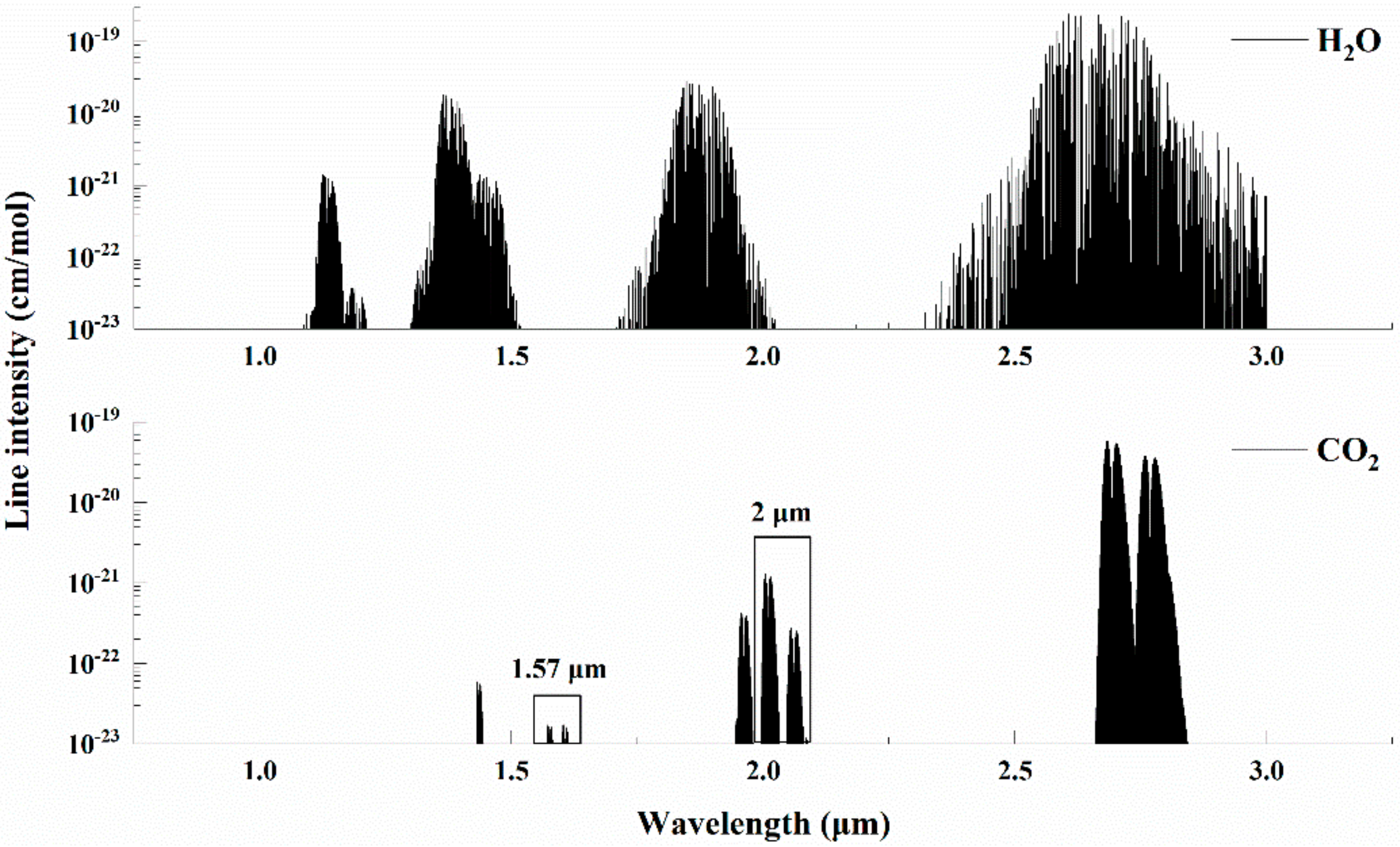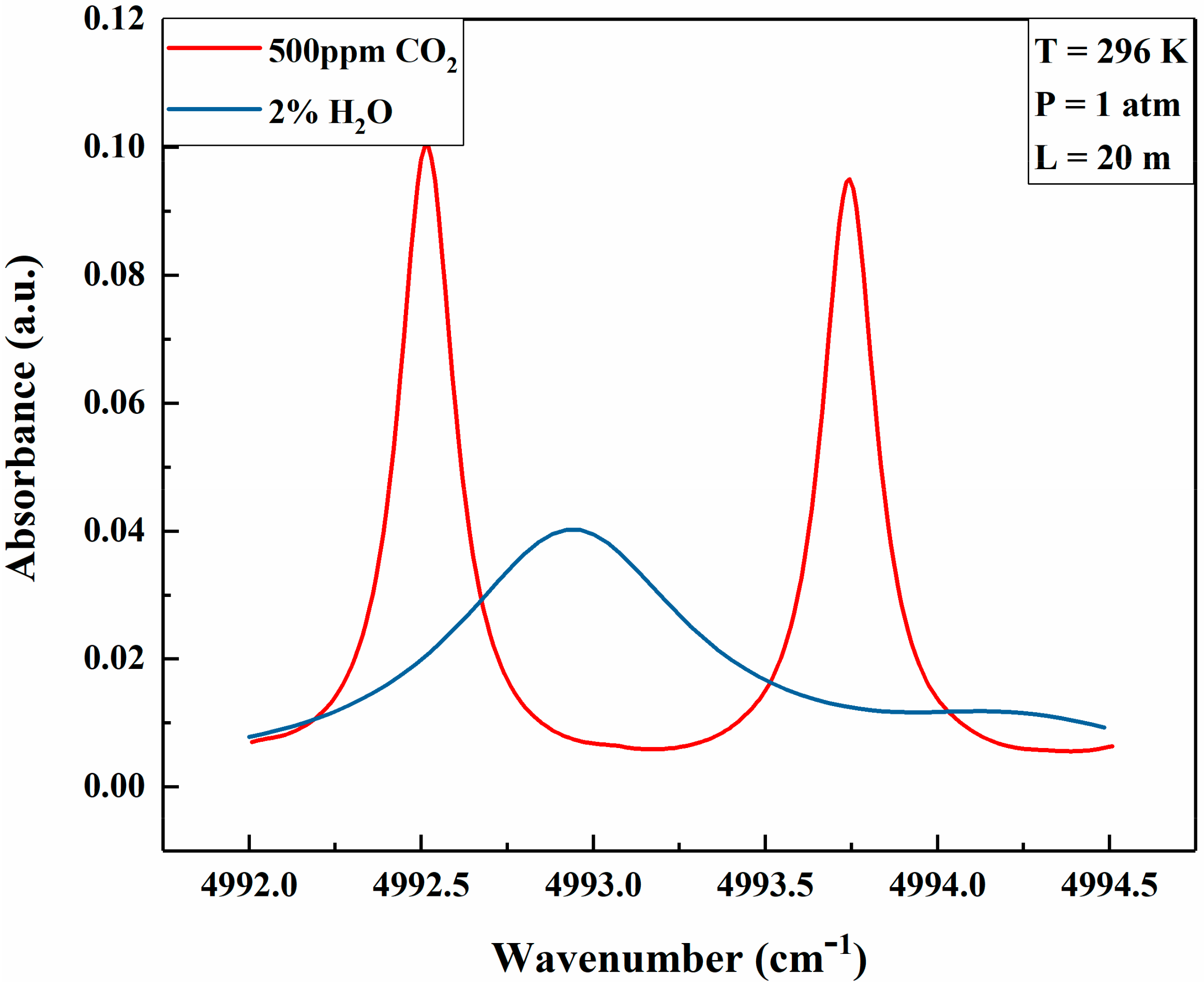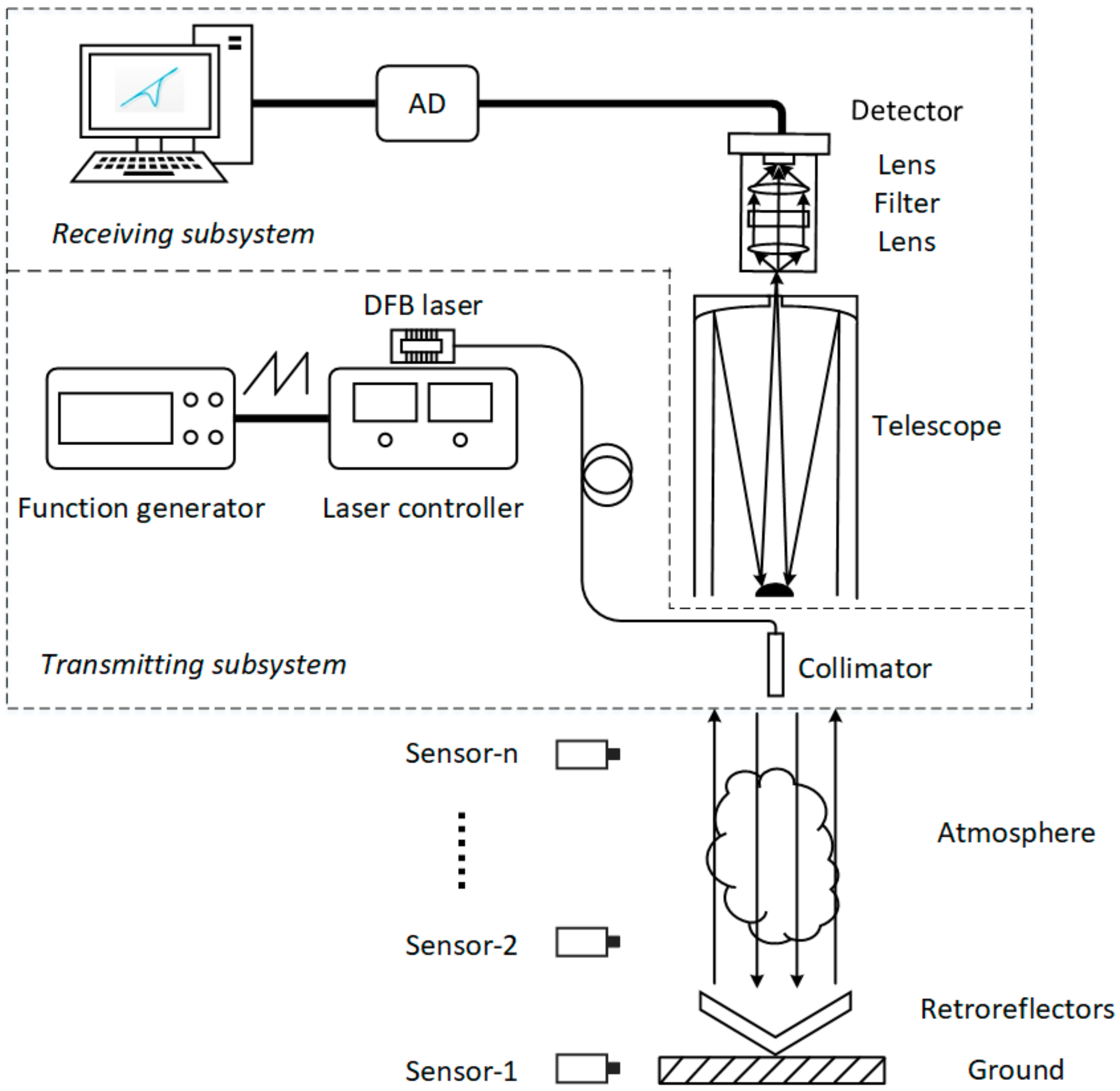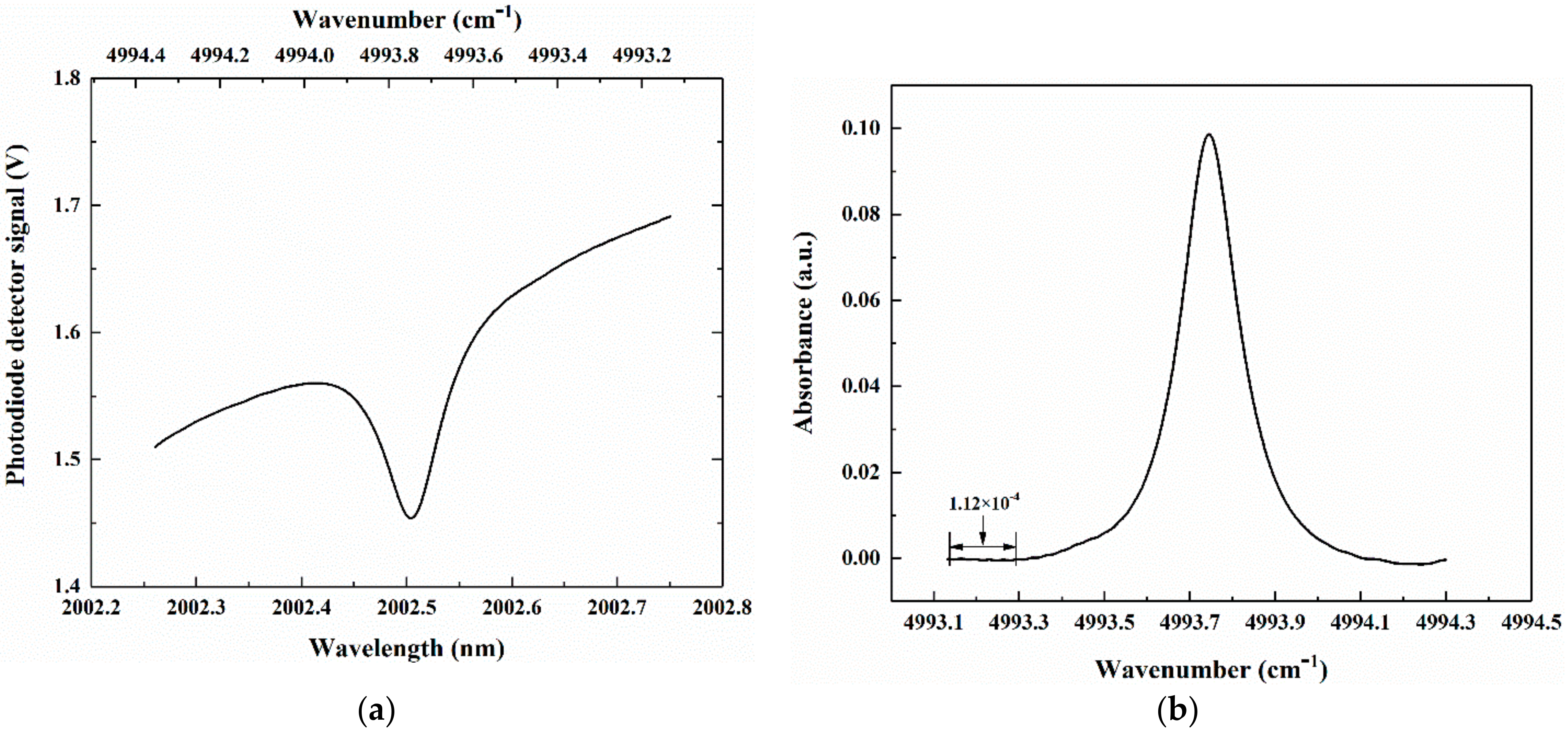Measurement of Atmospheric CO2 Column Concentrations Based on Open-Path TDLAS
Abstract
:1. Introduction
2. Theoretical Principle
3. Experimental Configuration
3.1. Selection of Carbon Dioxide Absorption Bands
3.2. Experimental Set-Up
4. Measurements and Results
5. Discussion
6. Conclusions
Author Contributions
Funding
Institutional Review Board Statement
Informed Consent Statement
Data Availability Statement
Acknowledgments
Conflicts of Interest
References
- Pachauri, R.; Reisinger, A. Climate Change 2014: Synthesis Report. Contribution of Working Groups I, II and III to the Fifth Assessment Report of the Intergovernmental Panel on Climate Change. J. Rom. Stud. 2014, 4, 85–88. [Google Scholar]
- Pelletier, C.; Rogaume, Y.; Dieckhoff, L.; Bardeau, G.; Pons, M.; Dufour, A. Effect of combustion technology and biogenic CO2 impact factor on global warming potential of wood-to-heat chains. Appl. Energy 2019, 235, 1381–1388. [Google Scholar] [CrossRef]
- Petit, J.-R.; Raynaud, D. Forty years of ice-core records of CO2. Nat. Cell Biol. 2020, 579, 505–506. [Google Scholar] [CrossRef] [PubMed] [Green Version]
- Butler, H.; Montzka, S. The NOAA Annual Greenhouse Gas Index (AGGI). Updated: Spring 2020. Available online: https://www.esrl.noaa.gov/gmd/aggi/aggi.html (accessed on 23 January 2021).
- Bowen, J.; Ward, C.; Kling, G.; Cory, R. Arctic Amplification of Global Warming Strengthened by Sunlight Oxidation of Permafrost Carbon to CO2. Geophys. Res. Lett. 2020, 47, 1–8. [Google Scholar] [CrossRef]
- Abshire, J.; Riris, H.; Weaver, C.; Mao, J.; Allan, G.; Hasselbrack, W.; Browell, E. Airborne measurements of CO2 column absorption and range using a pulsed direct-detection integrated path differential absorption lidar. Appl. Opt. 2013, 52, 4446–4461. [Google Scholar] [CrossRef]
- Qin, X.; Nakayama, T.; Matsumi, Y.; Kawasaki, M.; Ono, A.; Hayashida, S.; Imasu, R.; Lei, L.; Murata, I.; Kuroki, T.; et al. Ground-based measurement of column-averaged mixing ratios of methane and carbon dioxide in the Sichuan Basin of China by a desktop optical spectrum analyzer. J. Appl. Remote Sens. 2017, 12, 012002. [Google Scholar] [CrossRef]
- Shibata, Y.; Nagasawa, C.; Abo, M. Development of 1.6 μm DIAL using an OPG/OPA transmitter for measuring atmospheric CO2 concentration profiles. Appl. Opt. 2017, 56, 1194–1201. [Google Scholar] [CrossRef]
- Ma, X.; Zhang, H.; Han, G.; Xu, H.; Shi, T.; Gong, W.; Ma, Y.; Li, S. High-Precision CO2 Column Length Analysis on the Basis of a 1.57-μm Dual-Wavelength IPDA Lidar. Sensors 2020, 20, 5887. [Google Scholar] [CrossRef]
- Zhu, Y.; Liu, J.; Chen, X.; Zhu, X.; Bi, D.; Chen, W. Sensitivity analysis and correction algorithms for atmospheric CO2 measurements with 1.57-µm airborne double-pulse IPDA LIDAR. Opt. Express 2019, 27, 32679–32699. [Google Scholar] [CrossRef]
- Ramanathan, A.K.; Nguyen, H.M.; Sun, X.; Mao, J.; Abshire, J.B.; Hobbs, J.M.; Braverman, A. A singular value decomposition framework for retrievals with vertical distribution information from greenhouse gas column absorption spectroscopy measurements. Atmos. Meas. Tech. 2018, 11, 4909–4928. [Google Scholar] [CrossRef] [Green Version]
- Lauwers, T.; Glière, A.; Basrour, S. An all-Optical Photoacoustic Sensor for the Detection of Trace Gas. Sensors 2020, 20, 3967. [Google Scholar] [CrossRef]
- Brown, D.; Brown, A.; Edwards, P.; Liu, Z.; Philbrick, C. Measurement of atmospheric oxygen using long-path supercontinuum absorption spectroscopy. J. Appl. Remote Sens. 2014, 8, 83557. [Google Scholar] [CrossRef] [Green Version]
- Elia, A.; Franco, C.D.; Spagnolo, V.; Lugarà, P.M.; Scamarcio, G. Quantum Cascade Laser-Based Photoacoustic Sensor for Trace Detection of Formaldehyde Gas. Sensors 2009, 9, 2697–2705. [Google Scholar] [CrossRef] [Green Version]
- Queißer, M.; Burton, M.; Fiorani, L. Differential absorption lidar for volcanic CO₂ sensing tested in an unstable atmosphere. Opt. Express 2015, 23, 6634–6644. [Google Scholar] [CrossRef] [PubMed]
- Griffith, D.; Pöhler, D.; Schmitt, S.; Hammer, S.; Vardag, S.; Platt, U. Long open-path measurements of greenhouse gases in air using near-infrared Fourier transform spectroscopy. Atmos. Meas. Tech. 2018, 11, 1549–1563. [Google Scholar] [CrossRef] [Green Version]
- Butz, A.; Guerlet, S.; Hasekamp, O.; Schepers, D.; Galli, A.; Aben, I.; Frankenberg, C.; Hartmann, J.; Tran, H.; Kuze, A.; et al. Toward accurate CO2 and CH4 observations from GOSAT. Geophys. Res. Lett. 2011, 38, 130–137. [Google Scholar] [CrossRef] [Green Version]
- Ohyama, H.; Kawakami, S.; Tanaka, T.; Morino, I.; Uchino, O.; Inoue, M.; Sakai, T.; Nagai, T.; Yamazaki, A.; Uchiyama, A.; et al. Observations of XCO2 and XCH4 with ground-based high-resolution FTS at Saga, Japan, and comparisons with GOSAT products. Atmos. Meas. Tech. 2015, 8, 5263–5276. [Google Scholar] [CrossRef] [Green Version]
- Christoph, K.; Sebastian, T.; Bernhard, R.; Ulrich, P. Applicability of light-emitting diodes as light sources for active differential optical absorption spectroscopy measurements. Appl. Opt. 2006, 45, 2077–2088. [Google Scholar]
- Avetisov, V.; Bjoroey, O.; Wang, J.; Geiser, P.; Paulsen, K.G. Hydrogen Sensor Based on Tunable Diode Laser Absorption Spectroscopy. Sensors 2019, 19, 5313. [Google Scholar] [CrossRef] [Green Version]
- Li, C.; Dong, L.; Zheng, C.; Tittel, F.K. Compact TDLAS based optical sensor for ppb-level ethane detection by use of a 3.34 μm room-temperature CW interband cascade laser. Sens. Actuators B Chem. 2016, 232, 188–194. [Google Scholar] [CrossRef] [Green Version]
- Hartmann, A.; Strzoda, R.; Schrobenhauser, R.; Weigel, R. CO2 sensor for mainstream capnography based on TDLAS. Appl. Phys. B 2014, 116, 1023–1026. [Google Scholar] [CrossRef]
- Guo, X.; Zheng, F.; Li, C.; Yang, X.; Li, N.; Liu, S.; Wei, J.; Qiu, X.; He, Q. A portable sensor for in-situ measurement of ammonia based on near-infrared laser absorption spectroscopy. Opt. Laser Eng. 2019, 115, 243–248. [Google Scholar] [CrossRef]
- Xia, J.; Zhu, F.; Zhang, S.; Kolomenskii, A.; Schuessler, H. A ppb level sensitive sensor for atmospheric methane detection. Infrared Phys. Techn. 2017, 86, 194–201. [Google Scholar] [CrossRef]
- Seidel, A.; Wagner, S.; Ebert, V. TDLAS-based open-path laser hygrometer using simple reflective foils as scattering targets. Appl. Phys. B 2012, 109, 497–504. [Google Scholar] [CrossRef]
- Yao, L.; Liu, W.; Liu, J.; Kan, R.; Xu, Z.; Ruan, J.; Dai, Y. Research on Open-Path Detection for Atmospheric Trace Gas CO Based on TDLAS. Chin. J. Lasers 2015, 42, 305–312. [Google Scholar]
- Zimmerman, J.; Ii, R.; Blakley, C.; Frish, M.; Laderer, M.; Wainner, R. Tunable Diode Lase Absorption Spectrometers for CO2 Wellhead and Pipeline Leakage Monitoring: Experiences from Prototype Testing at the Illinois Basin—Decatur Project, USA. Energy Procedia 2014, 63, 4083–4094. [Google Scholar] [CrossRef] [Green Version]
- Bailey, D.; Adkins, E.; Miller, J. An open-path tunable diode laser absorption spectrometer for detection of carbon dioxide at the Bonanza Creek Long-Term Ecological Research Site near Fairbanks, Alaska. Appl. Phys. B 2017, 123, 245. [Google Scholar] [CrossRef]
- Xia, J.; Zhu, F.; Zhang, S.; Kolomenskii, A.; Dong, J.; Okada, K.; Strohaber, J.; Schuessler, H. Probing greenhouse gases in turbulent atmosphere by long-range open-path wavelength modulation spectroscopy. Opt. Laser Eng. 2019, 117, 21–28. [Google Scholar] [CrossRef]
- Rothman, L.S.; Gordon, I.E.; Babikov, Y.; Barbe, A.; Benner, D.C.; Bernath, P.F.; Campargue, A. The HITRAN2012 molecular spectroscopic database. J. Quant. Spectrosc. Radiat. Transf. 2013, 130, 4–50. [Google Scholar] [CrossRef] [Green Version]
- Xin, F.; Guo, J.; Sun, J.; Li, J.; Zhao, C.; Liu, Z. Research on atmospheric CO2 remote sensing with open-path tunable diode laser absorption spectroscopy and comparison methods. Opt. Eng. 2017, 56, 066113. [Google Scholar] [CrossRef]








| Techniques | Light Source | Distance | Direction | Detection Limit | Comparison Sensors | Reference |
|---|---|---|---|---|---|---|
| FTIR | Lamp | 1.5 km | Horizontal | 1.6 ppm | Single | [16] |
| DOAS | LED | 3.045 km | Horizontal | - | - | [19] |
| TDLAS | DFB laser | 0.2 km | Horizontal | 5.4 ppm | Single | [28] |
| TDLAS | DFB laser | 1.3 km | Horizontal | 20 ppm | - | [29] |
| TDLAS | DFB laser | 0.11 km | Vertical | 0.52 ppm | Multiple | This work |
Publisher’s Note: MDPI stays neutral with regard to jurisdictional claims in published maps and institutional affiliations. |
© 2021 by the authors. Licensee MDPI, Basel, Switzerland. This article is an open access article distributed under the terms and conditions of the Creative Commons Attribution (CC BY) license (http://creativecommons.org/licenses/by/4.0/).
Share and Cite
Xin, F.; Li, J.; Guo, J.; Yang, D.; Wang, Y.; Tang, Q.; Liu, Z. Measurement of Atmospheric CO2 Column Concentrations Based on Open-Path TDLAS. Sensors 2021, 21, 1722. https://doi.org/10.3390/s21051722
Xin F, Li J, Guo J, Yang D, Wang Y, Tang Q, Liu Z. Measurement of Atmospheric CO2 Column Concentrations Based on Open-Path TDLAS. Sensors. 2021; 21(5):1722. https://doi.org/10.3390/s21051722
Chicago/Turabian StyleXin, Fengxin, Jie Li, Jinjia Guo, Dewang Yang, Yong Wang, Qiuhua Tang, and Zhishen Liu. 2021. "Measurement of Atmospheric CO2 Column Concentrations Based on Open-Path TDLAS" Sensors 21, no. 5: 1722. https://doi.org/10.3390/s21051722







